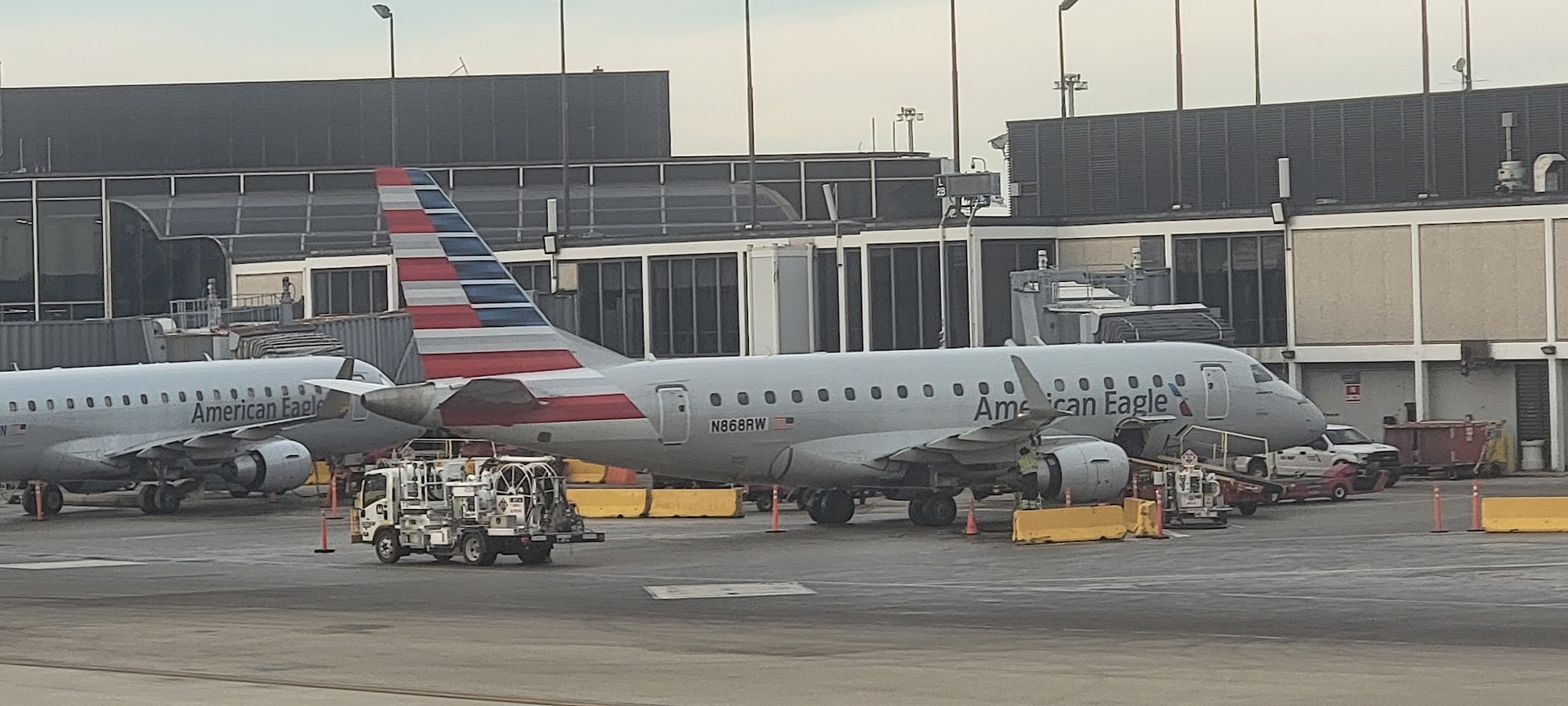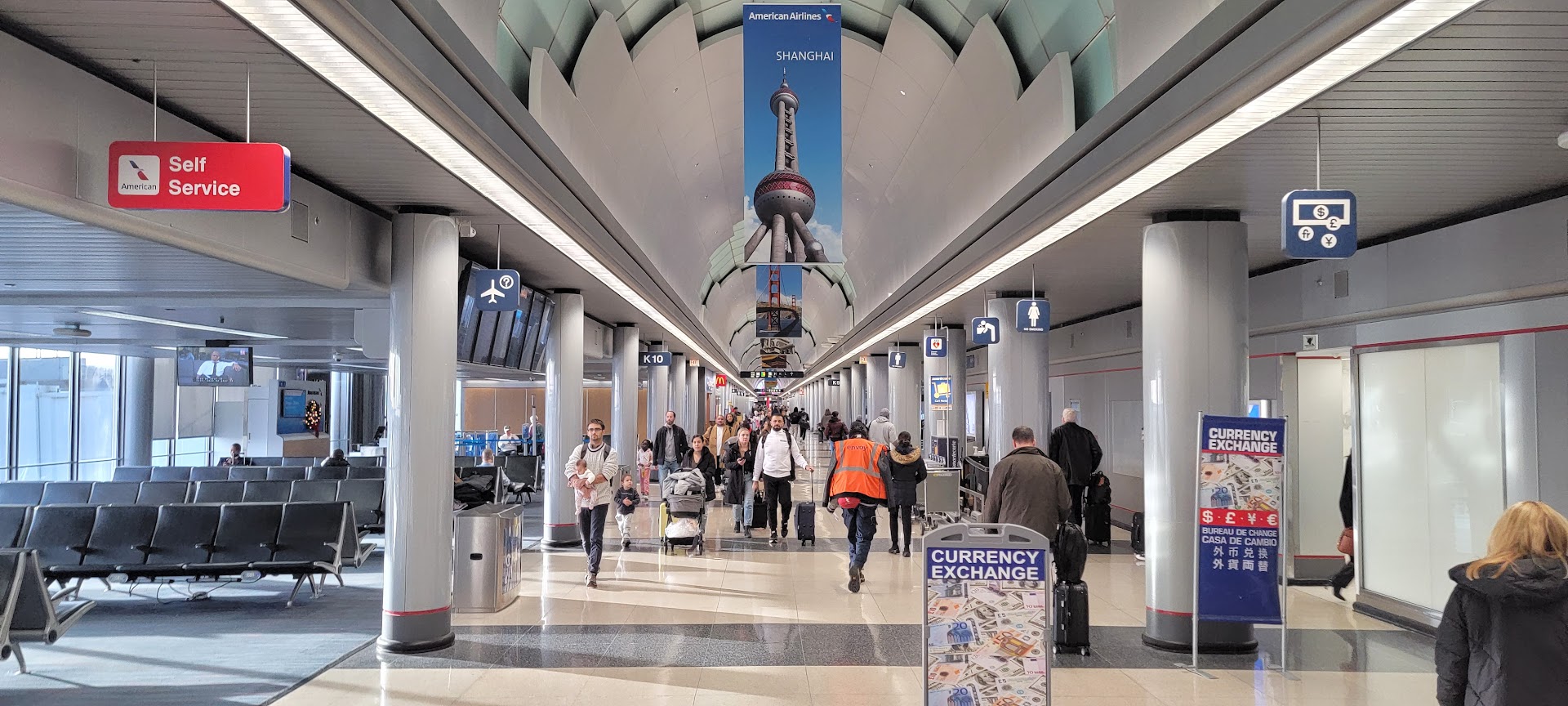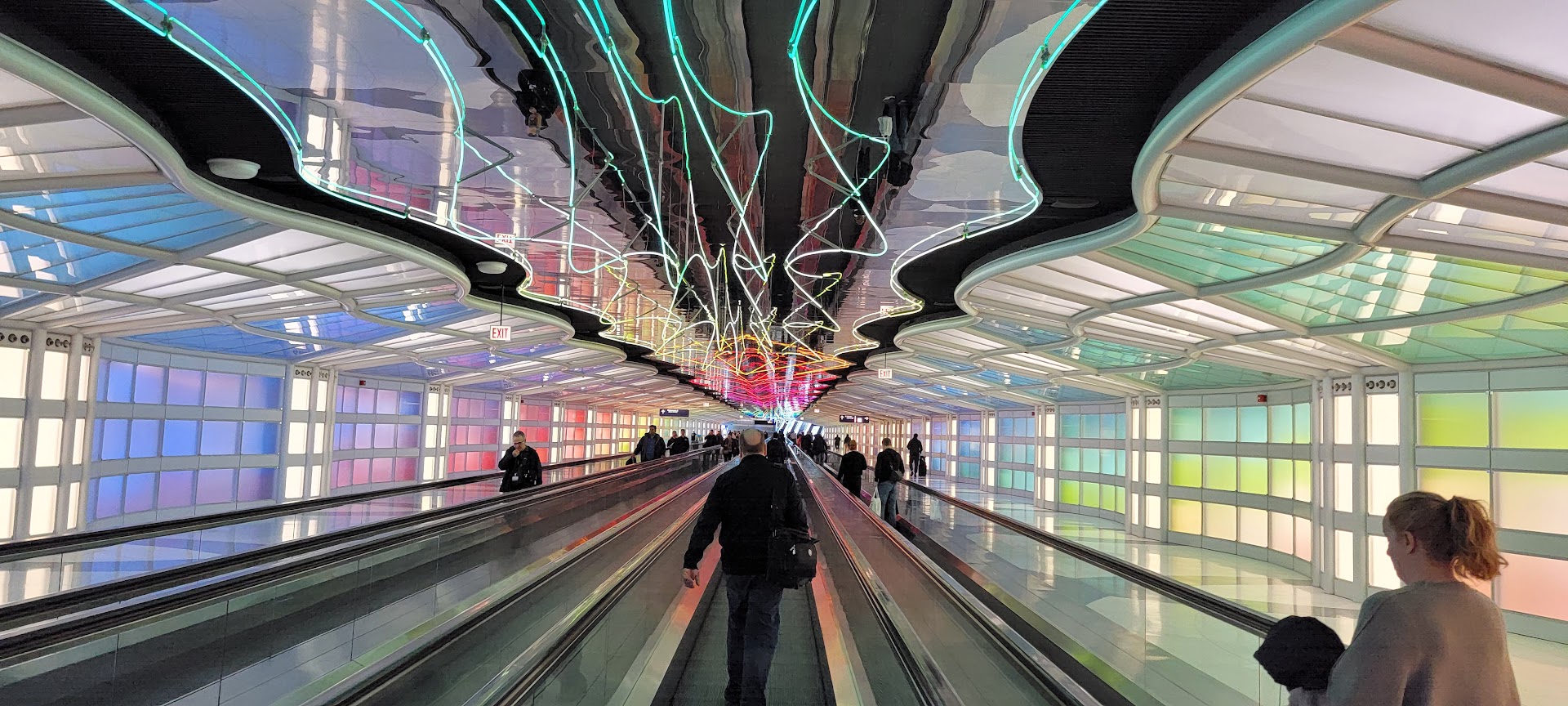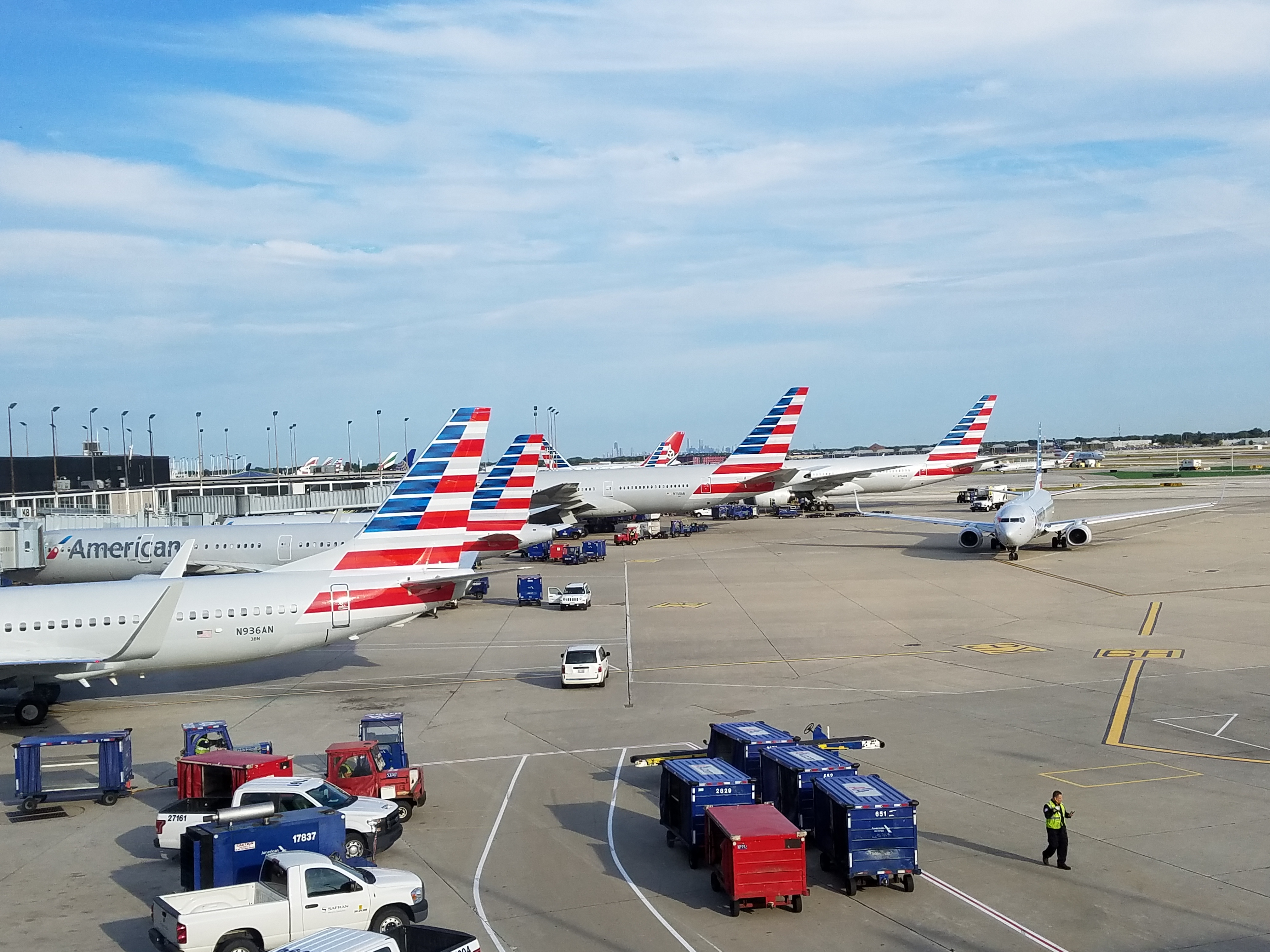United Airlines CEO Scott Kirby loves to tout his airline’s superior performance to American Airlines. He became United’s President 9 years ago after being fired from American. In a set of slides he rubs salt in the wounds over his airline’s relative growth in size and financial performance at Chicago O’Hare, where both airlines operate hubs.
However, what these slides leaked by aviation watchdog JonNYC largely show is United growing its operation in Chicago coming out of the pandemic, while American retired too many planes and focused rebuilding its own route network on the Sun Belt – and it points to the fundamental problem with the City of Chicago’s plans to give more gates to United at the expense of American. That plan is anti-competitive and will harm Chicago passengers.

American and United were neck and neck with each other with local Chicago customers (as opposed to connecting passengers, who can connect through a variety of hubs) before the pnademic. But United has been gaining share there ever since. That’s even more dramatically the case with managed business travelers.
More UA bAAllbusing slides 🙂
— JonNYC (@xjonnyc.bsky.social) July 22, 2025 at 11:28 PM
The difference has become stark. Anyone watching airline news won’t be surprised, since American has mostly ignored its Chicago hub for the last five years. It’s only just announced an expansion there, as the city plans to re-allocate gates away from American and to United which has been growing (American objects that their lease doesn’t actually allow this yet).
2015 is an interesting base year because it’s the last full year where United CEO Scott Kirby was the President of American Airlines.

So what’s actually going on here?
Some of this is just a function of O’Hare flying.
- Under disgraced ex-CEO Jeff Smisek era, United was shrinking domestically. They flew a lot of smaller aircraft across their domestic network. Reversing this was an explicit strategy of current CEO Scott Kirby – because he felt that size in a market would determine the airline’s share (and drive a disproportionate share of credit card acquisition).
- According to data from aviation analytics company Cirium, the percentage of local traffic reported by United tracks fairly closely with the percentage of seats at O’Hare that each airline operates, within a few percentage points each year – although the gap here has been widening.
- American built back O’Hare more slowly after the pandemic than United did. It also scaled back international flying from Chicago, and hasn’t had the large aircraft either – since it retired Airbus A330s and Boeing 767s during the pandemic and then Boeing delayed deliveries of the 787s it had on order. Their decision to remove premium seats from aircraft meant they didn’t have enough to sell in Chicago.

Some of this is a function of customers walking away from American.
- The percentage of American’s revenue from frequent flyers dropped markedly between 2016 and 2020, with the airline filling planes at low fares from infrequent flyers.
Before the pandemic started, 45% of American revenue came from 38% of customers flying more than once a year. However, four years earlier 50% of revenue came from just 13% of flyers. Getting even close to half of revenue required broadening the customer base in a short four years.
That followed a period of sharp devaluations in AAdvantage as well as product under US Airways management, and that management’s focus on competing mainly with Spirit and Frontier believing their model was the path to profitability (an odd position for a high cost carrier to take, and it did not work).
- And American now has a significant net promoter score deficit to United (and Delta).
- They decided they didn’t need to sell corporate travel, or to travel agencies, anymore. They’ve been working to reverse this by offering deep, deep discounts and incentives. Their thesis that business travel was on a permanently lower trajectory seems accurate (confirmed by Delta’s experience shared during its second quarter earnings call), and they believed they’d get their natural share based on route network anyway but without the sales expense and discounting (didn’t turn out to be right). They even gutted their small business rewards program. It turns out that pricing and rewards matter.

United has had better facilities in Chicago. Their size is supported by gate space. And that advantage is growing. In that sense, there’s a built-in advantage that’s growing provided they choose to continue flying heavily from the city.


However, the number of seats per aircraft is directly under the control of each carrier. And the decline in customer preference for American is reversible under the right management strategy.
The idea that brand loyalty advantages are irreversible is silly. There was far less brand loyalty to United in 2015. They’re behind Delta in a decades-long effort to build this, just as they are still behind Delta in operational reliability and employee friendliness. (And United is unlikely to match Delta’s service levels unless Delta declines.)

What’s absolutely bizarre is that the government in Chicago looks at United’s growth and says ‘we want to constraint competition even further’ planning to hand United more of the public airport’s gate space, taking it away from American. That will give United even more pricing power, at the expense of customers having choices.


Keep stirring the ORD pot, Gary!
As to brand-loyalty, generally, I still prefer Delta over United and American, after decades of experiences and top-tier status with each (Diamond, 1K, EP, no I never got 360, GS, or CK, boohoo); we’ve certainly seen our fair share of changes to these programs over the years (some better, some worse). I still prefer an airline with IFE, free WiFi, and upgrades like RUCs and GUCs that actually confirm in advance (unlike SWU and PlusPoints which are often Waitlist until the gate, if at all.)
I’m not sure how “use it or lose it” is anticompetitive. One could argue that AA’s underutilization of gates which limits the ability of airlines who want to actually use the gates is the anticompetitive behavior here. Kind of like the slot squatters in NY and DCA.
United is the hometown airline of Chicago. However, giving preferential treatment with allotting additional gates to United is definitely doing a disservice to the people of Chicago. United overwhelms ORD so this seems to be overkill by them. As for Scott Kirby’s revenge, maybe he should consider the volatility of the Airline Industry. Karma is a powerful thing and Airline Execs come and go. So do passengers. No I do not work for American, but I am an American.
Even with the new gate allocation, AA would still have 59 gates. That still seems pretty substantial. I can’t think of any other hub airports where the number two carrier has that many gates.
And that’s before throwing WN at MDW into the mix.
very accurate article, Gary but all that matters is what happened/ is happening in Chicago.
AA simply was not able to deal w/ the losses that ORD was generating for them during covid and wanted to chase higher revenue in its southern hubs.
If ORD wasn’t a very competitive market, that would have all made sense. But taking their foot off the gas in Chicago gave UA an opening.
And, yes, Kirby, loves to trash ANYONE and is hypercompetitive.
The real question – as has been discussed before – is whether AA was legally using its gates as it was supposed to. The question of whether AA can regain what it has lost is quite another thing.
and the real irony of all of this is that Delta is doing the exact same thing to United in New York City. UA overscheduled EWR for years convinced that a single airport hub system was viable in NYC, EWR was a chronically poor on-time airport, the Port Authority decided it had to repave a runway, and UA failed to cancel down to the available capacity at EWR during that construction period.
EWR melted down including due to spring storm, UA execs including Kirby mercilessly trashed the FAA and DOT and asked for slot controls to be reinstated at EWR – which were stripped almost 10 years ago due to UA’s failure to comply with slot usage requirements.
The FAA and DOT were tired of being trashed by UA on a daily basis in the media so imposed strict capacity controls on EWR not just for the remainder of the immediate closure of that runway but into the fall. In the process, UA has given up the title as NYC’s largest airline by a pretty wide margin to DL who carried 25% more passengers including substantially more domestic passengers than UA.
So, yes, AA took its foot off the gas in Chicago and is paying the price but UA was running an unsustainably “hot” operation at EWR and pursued a hub strategy in NYC that was not capable of being the largest – while DL has hubs at two of NYC’s airports.
NYC is, of course, a larger market than Chicago and ORD is undergoing a massive rebuilding that will make it the most expensive major connecting airport in the country.
Let’s see how it all plays out legally and competitively but karma really is, well, you know
@Parker – “I’m not sure how “use it or lose it” is anticompetitive. ”
First, the lease doesn’t allow the gate reallocation process yet. That’s why American is suing.
Second, “use it or lose it” is different than “reallocate gates from everyone to the dominant carrier, blocking competition” and the formula Chicago is using likely accelerates future reallocations because United will be able to grow its flying in Chicago further and take away more gates.
No reason to give United more preferential use gates and block new entrants and smaller airlines, and American’s schedule added ~ 25% more seats to Chicago but the reallocation will force them to cut back, under the terms of the lease they *are* using the gates.
If you’re Chicago based and aren’t corporately captive you’d have to be mad to pick AA over UA. AA has been squatting on and mismanaging ORD resources for years, they should go to carriers who are actually going to use them.
@Tim Dunn — I appreciate all the ‘New York City is better than Chicago’ talk above. Bah! That is a fascinating comparison of this ORD issue to the current fights over space in the NYC region. On United at EWR, I will say, although they still blame the FAA staffing shortages for all their delays there, the runway situation is now resolved, so things are a bit smoother. As to Delta, that hail storm in Atlanta on June 27, and the brief Endeavor grounding June 5-6, was not ‘great’ either. Clearly, everybody is trying their best, yet things do happen. Wonder what else we’ll see by the end of the year. Like, that brief Alaska Airlines IT gave me flashbacks to Crowdstrike… thankfully, not that bad.
1990,
there is and always be a list of challenges that airlines have to overcome.
My point is about anyone having the gall to trash a competitor to gain a short term advantage rather than just winning on a year in and year basis which is the way DL has built itself.
UA and Scott Kirby would be a whole lot more successful if they could just talk about what UA is doing and quit comparing themselves to other airlines; the more he opens his mouth, the more he seems like a high school girl that hasn’t “developed” as fast as someone else.
and you do realize that the Delta-CrowdStrike lawsuit did get the green light to go ahead – in a, wait, wait, Georgia court.
The hometown advantage is fine – but use it fairly. If CRWD doesn’t think that they can get a fair trial in GA, you would think there are mechanisms to move the trial to, say, Arkansas.
Maybe AA’s lawyers should be thinking about the same thing w/ the City of Chicago
The gate reallocation appears anti-competitive, but it is not IMO. The idea is simple if you exaggerate for effect: If you, as an airline, have 40% of the gates, but only operate 20% of the flights, you are under utilizing airport assets – and another airline that shows it can offer more flights per gate better serves the public. Transferring gates to a carrier that has better utilization will either provide the public with direct flights to new destinations or provide more frequent flights to existing destinations. Both are good results.
The actual numbers according to reports that came out back in February say United uses 48% of the gates, but operates 52% of the departures from O’hare. If the reallocation goes through, United should have 52% of the gates to match their share of flights. Afterwords, both UA and AA (and any other airline) have the opportunity to increase the utilization of their available gates an apply for more gates down the road, if they are doing a better job than the competition of getting flights out. It’s not anti-competitive to have the ratio of gates match the ratio of departures.
Another way to see this: the airport simply has the ability to say, “Sorry, (airline “xxx”) – you are only averaging 7 flights a day out from your gates, and (airline “yyy”) averages 10… so you should be able to operate the same number of flights if we consolidate your operations into a few less gates, and you bump your “flights per gate” numbers up to what the competition shows can be done.”
This pro-rated gate allocation allows the airport to offer even more total flights, without building any new infrastructure. And that’s a win for passengers. Whether it will really happen or not as AA sues to block it remains to be seen.
AA consciously made a decision to pivot from ORD, until they started losing gates. Now all of a sudden they are adding routes, bus service (even though the RFD-ORD afternoon service misconnects with QR/RJ, seriously), etc.
AA will lose in court and ORD has delivered the message to AA and how things will work…
@Tim Dunn — I admire anyone willing to ‘play the long game,’ however, these days, it seems like ‘short-term wins’ are all anyone cares about anymore. Layoff 25% of your staff? Sure, why not, the C-suite needs ‘line go up’ for this (and every) quarter.
Oof, ‘developed…’ now that’s some locker-room talk!
Hopefully Delta will get some money back from Crowdstrike, after all. As to forum shopping, I thought corporations preferred the U.S. District Court for the Northern District of Texas, or maybe that’s just for injunctions against Democrats. Judge Matt K. will sign-off on anything! (if you’re on the right ‘team’… *sigh*)
There is an implicit assumption behind wanting to have AA retain more gates at ORD and that is that there are more people that want to fly AA to absorb whatever additional capacity they choose to put there. I question if the incremental volume would be there. AA realized in the last year or so that the were getting “NYCed” in Chicago after years of mistakes. Good luck trying to recover.
Regarding EWR (my home airport) and United – we’ve been inundated with United ads over the last month or so proclaiming EWR/United is the #1 on time NY airport. That doesn’t compute for any customer, even if that data is accurate. The experience/memories of flying in/out of EWR this year are long. This also comes across as a cheap shot at Delta over at JFK. Not an effective way to win business. I’ve remained a Delta loyal since moving here 12 years ago. I have dabbled with United over the last few years, but I won’t switch. Their ground operations around Term. C are horrible. I’ve actually timed it out – fly Delta with a connection, or fly United and sit on the ground 50 yards form the gate for an an hour plus on arrival. After an “n” of 15 on united, the time to/from destination is pretty close to the same as Delta with a connection. I’m the kind customer I would think United would be trying to get (DL Diamond based in NJ) but United continues to make it easy for me not to switch. Daughter flying home this Friday afternoon from ORD. We’re already planning for a significant inbound delay for her – as usual.
The whole intent is to make sure the airlines are using the airport capacity given to them. American only started increasing their flight capacity at ORD once they saw they were going to lose their gates. United has been increasing capacity on a sustained basis. If they stop, they will lose those extra gates allocated to them. I don’t see how this is anticompetitive at all.
regarding NYC, the DOT actually tracks on-time performance and has released data for April which includes when the EWR runway was closed for reconstruction.
DOT domestic data for April shows that EWR had a 68.2% on-time rating, JFK was 81.5 and LGA was 80.6%. The US as a whole had a 79.6% on-time so JFK and LGA were slightly above average while EWR was well below average.
The DOT intervened and imposed deep flight cuts at EWR in May.
The DOT has not provided on-time data for June which was when the runway reopened -partway through the month. It would not be a surprise if EWR did better than JFK or LGA.
UA is desperately trying to argue for higher flight levels being restored to EWR but it is doubtful the DOT will do anything before October and they will also look at historical data as well as EWR on-time since the flight caps were imposed; given that nothing has really changed in terms of infrastructure, it is very, very unlikely that the DOT would allow EWR flight levels to return to what existed before the runway project.
UA is certain to have permanently lost share and DL (as well as AA) are certain to be cementing the share gains they have had at UA’s expense.
None of the NYC airports will ever be consistently at or above national on-time averages. the DOT is simply going to do what it can to accommodate demand while not allowing the consistent operational meltdowns that have been the norm at EWR.
and remember that many of those meltdowns have been due to a lack of gates and parking areas during bad weather so the chances of future meltdowns are still fairly high; those types of meltdowns have happened EVEN UNDER the deep flight cuts.
EWR is simply not near as well suited for a hub that uses 65% of the capacity of EWR; AA and DL’s hubs at LGA and JFK are far less peaked esp. at LGA and have much more space on the ground and runways at JFK.
as for Chicago, airports have every incentive to have their gates used as much as possible. They can’t make up rules after contracts are signed or force changes which are different from their contracts without agreement from all parties.
I do hope AA fights the City of Chicago but I’m not sure if AA can recover what it has lost.
It’s as if the author knows less about how airports are financed than he does about S curves. I missed the articles about ATL and DFW stifling competition. The ignorance is astounding. And who knew one can be a legal expert while being unencumbered by any applicable expertise or experience. Too funny.
@JL – you did miss those articles, read harder
You mean read more ‘Thought Leader in Travel’ tripe? No thanks. Makes sense though from an Austrian school type. Here in the real world US cities don’t/can’t come up with the money to finance airports so the airlines have a lot of influence of the access to gates and facilities. And given that UA is significantly bigger (S curve) and more profitable at ORD, AA is going to cede market share one way or another. It would probably save them a lot of $ if they lose their lawsuit. Of course according to your expert legal opinion there is no way they should.
@JL — Hey, now… some folks enjoy eating all parts of the cow. After all, tripe is a good source of protein, vitamins, and minerals, particularly vitamin B12, selenium, and zinc. Yum!
Speaking of ‘Austrian school,’ you’d find good company with @Mike P, a fellow anarcho-libertarian. If you tease him enough, that guy will quote (uncle) Tom Sowell and Twain to you. Good times!
Fundamentally, the declared mission statement of the Chicago Department of Aviation is to “enhance the economy and connectivity of Chicago”, and not to ensure lowest prices for airline travel. If they’re not as confident in American’s plan to actually fly the routes and invest in passenger growth at O’Hare as they are in United’s plan, then an allocation of gates to American’s favor would go against their mission statement.
Like ok fine, you don’t like the mission statement because it’s not focused on lowering prices, but tough to argue they’re not following their purpose if they don’t believe American’s management.
@Helios — What do you think the word ‘economy’ means within the context of that mission? Increased competition usually results in lower costs for consumers, higher wages for workers, etc. The folks that do not benefit are those seeking to maximize profits. It’s always been a class war.
“What’s absolutely bizarre is that the government in Chicago looks at United’s growth and says ‘we want to constraint competition even further’ planning to hand United more of the public airport’s gate space, taking it away from American. That will give United even more pricing power, at the expense of customers having choices.”
I think it’s wrong to claim Chicago wants to constrain competition. Chicago is rewarding the carrier that has invested in O’Hare instead of the one that has decreased its investment at O’Hare during that same period. From another article: “In 2024, [American] flew 12% more seats out of Dallas Fort Worth International Airport (DFW) than it did in 2019, per Cirium. Its seats out of Miami International Airport (MIA) were up nearly 15%, while seats out of Charlotte Douglas International Airport (CLT) were up close to 16% . . . . But American’s total seats out of O’Hare in 2024 lagged 2019 levels by some 21%.” So, Chicago looks at the two carriers and sees one intentionally prioritizing Chicago and one intentionally prioritizing investing in markets other than Chicago.
At the same time, however, the consequence of rewarding United is constraining competition in the Chicago market. And Chicago is unique for having three carriers with hubs at their two airports (United and American at O’Hare, and Southwest at Midway). The city should want competition to grow, not decrease. It’s better for consumers, and having two strong carriers at O’Hare will help fund future facility improvements. For that reason, I hope American’s effort to reverse the gate re-allocation is successful.
@ 1990 says, “Increased competition usually results in lower costs for consumers, higher wages for workers, etc. The folks that do not benefit are those seeking to maximize profits.”
Lower prices = higher wages? Try again.
Firstly, AA is in the right when it comes to contract interpretation. As long as the judge isn’t biased for UA or against AA, they should eventually win the lawsuit.. the earlier the easier it’ll be to remedy the situation and provide compensation.
Long term, this lease agreement is a winner take all through financial arbitrage. UA’s larger company wide profitability will allow them to subsidize ORD operations as necessary to a greater extent than AA can, and over time, whether its through willful retraction or bankruptcy, AA will have to cede gate space at ORD eventually. This lease agreement was designed by UA for UA to do exactly this.
If AA can whether the storm for a few more years, so they have time to pay down debt, expand with additional aircraft deliveries, and continue to invest in upmarket upsells, then they’ll be able to fight to standstill at ORD. Rather than financial arbitrate lease agreement, the lease should be changed to minimum gate utilization much like aircraft slots work in other airports.
Chicago is a better air travel market with two large hub carrier airports. If UA took over the whole thing they’ll ease back the schedule and increase prices. Once they have control, nobody will be able to enter the chicago market as UA will just squeeze them out, so nobody will even try.
@JL — If you re-order words, that often changes their meanings. You did that. So, allow me make it more clear for you: Increased competition leads to higher wages for workers. Increased competition also leads to lower prices for consumers. Yes, that can lower profits for the company/investors. I remain in-favor of better compensation for workers and better value for consumers in this context. If that means the capital class earns slightly less, then so be it. They still enjoy acceptable ROI.
Quick economic lesson: ‘ Increased competition in labor markets generally leads to higher wages for workers. When companies compete for employees, they must offer better pay and benefits to attract and retain talent. This dynamic is particularly relevant in markets with low competition, where employers may have more power to suppress wages.’
And, I get it, maybe you’re and investor, don’t care about the peasants, and just want to extra as much wealth as you can by exploiting other. Yeah, self-interest is a powerful motive. I think you can still get decent ROI without screwing everyone else.
The pleasure I find in reading Gary’s posts is to look for the typos. Is Gary so focused on posting volume that he can’t be bothered to proofread his own stuff? You insult the reader and call into question your veracity every single time you have ridiculous typos like this:
“American and United were nack and neck with each other with local Chicago customers…”
@ 1990 says, ” If you re-order words, that often changes their meanings. You did that.”
Increased competition usually results in lower costs for consumers, higher wages for workers, etc. The folks that do not benefit are those seeking to maximize profits.
“Increased competition usually results in lower costs for consumers, higher wages for workers, etc. The folks that do not benefit are those seeking to maximize profits.”
Nope. Pathetic attempt. Poor little 1990 or is it TD? Run along now.
American is the pauper’s airline, from the moment you walk on one of its planes and you realize they don’t even have TVs.
My guess is AA is going to win the court case but we’ll see.
AA is in this mess thanks to Parker & Co. Good job guys. Now AA’s a mess and Parker took his $40+ million and ran off to the sunset. Not bad for someone who was running a two-bit operation (Useless Airways). That being said, the unions got what they deserved. After all, it was the unions which “backstabbed” (then CEO) Horton and sided with the Useless Airways side to “merge” with AA. Idiots.
The Chicago Way
“UA is desperately trying to argue for higher flight levels being restored to EWR but it is doubtful the DOT will do anything before October and they will also look at historical data as well as EWR on-time since the flight caps were imposed; given that nothing has really changed in terms of infrastructure, it is very, very unlikely that the DOT would allow EWR flight levels to return to what existed before the runway project.”
Timmyboy is clueless as usual and obsessed with UAL. Just because UAL has been kicking DAL’s ass for a while now. Timmyboy I recommend you listen to UAL’s earnings calls since 2021. Start with the last one just last week. Kirby has been asking for flight reductions at EWR for years. Finally the DOT did it. It’s exactly the opposite of what you’re saying.